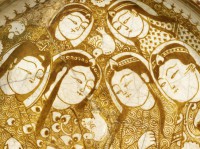Islamic Ceramics trail
Explore over one thousand years of development in Islamic ceramics through our extensive collection.

- This is a visual browsing tool that maps objects in this publication, gallery or collection trail by date of creation onto a timeline.
- The circular markers indicate where objects are on the timeline.
- The size of the markers indicates the relative number of objects at that point on the timeline.
- Hover over a marker to find out which objects are represented at that point in time.
- To expand, collapse or hide the timeline, click these symbols
 found at the top right of the timeline.
found at the top right of the timeline.
- 780
- 820
- 860
- 900
- 940
- 980
- 1020
- 1060
- 1100
- 1140
- 1180
- 1220
- 1260
- 1300
- 1340
- 1380
- 1420
- 1460
- 1500
- 1540
- 1580
- 1620
Ottoman ceramics
From the late 15th century, the potters in Ottoman Turkey had begun to develop a unique and refined type of ceramics. Catering for both the court and the market, this new type of ware was mostly produced in the kilns of Iznik, a town about 100 kilometres south of Istanbul. Potters employed a pure white frit body and a vibrant palette, with which they painted a wide range of patterns.
Early Iznik manufacture focused on vessels with a simple colour scheme of blue on white. By the 1520s, however, a first step towards polychromy was taken with the introduction of turquoise, which was combined on the white background with a lighter shade of blue. Patterns of Chinese inspiration - particularly the early 15th-century grapes design - were used alongside motifs rooted in the ‘international style' current in the Islamic lands from Central Asia to Syria.
 Dish with grapes (EA1978.1470)
Dish with grapes (EA1978.1470)
 Tondino dish with spiral patterning (EAX.3274)
Tondino dish with spiral patterning (EAX.3274)
 Hexagonal tile with floral decoration (EA1978.1536)
Hexagonal tile with floral decoration (EA1978.1536)
Green, ranging from sage to olive, and purple were added to the Iznik palette towards the mid 16th century. A corresponding change in patterns can be seen, with the introduction of bolder floral compositions.
In the second half of the 16th century a completely innovative colour scheme was introduced. Blue, black, emerald green and a thick red became the hallmark palette of Iznik producers. The red pigment, which had been the hardest to achieve, was obtained using an iron-rich slip that remained in slight relief. The repertoire of floral patterns shifted towards a more naturalistic one, including tulips, roses, carnations, and hyacinths.
Major architectural projects throughout the Ottoman empire called for an increased production of tiles, which now surpassed that of vessels, inverting the trend of the first half of the 16th century.
 Dish with roses and tulips (EA1978.1423)
Dish with roses and tulips (EA1978.1423)
 Tile with serrated leaves and flowers (EAX.3215)
Tile with serrated leaves and flowers (EAX.3215)
 Dish with a European ship (EA1978.1457)
Dish with a European ship (EA1978.1457)
Iznik manufacture thrived throughout the rest of the century, but declined during the 17th century. Provincial versions of Iznik ceramics were manufactured in other Ottoman centres such as Diyarbakır and Damascus. Tiles and vessels made in Syria during the 16th and 17th centuries show the use of a distinctive grass green, while the thick Iznik red is completely absent.
© 2013 University of Oxford - Ashmolean Museum



